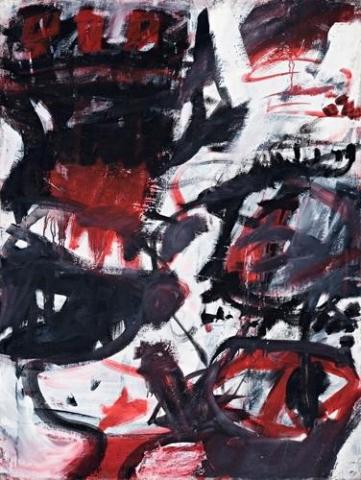PAINTING, c.1964
Tony Tuckson
synthetic polymer paint on composition board
122.0 x 91.5 cm
inscribed verso: Margaret Tuckson/ Joa… A…/ May1974/ Hogarth/ Artists for Whitlam./ $200/ Tuckson (Watters 1970) No 49
Watters Gallery, Sydney
Private collection
Deutscher Fine Art, Melbourne
Private collection, Melbourne
Tony Tuckson, Watters Gallery, Sydney, 1970, cat.49 (first one-man exhibition)
Artists for Whitlam, Hogarth Galleries, Sydney, May 1974
Australian and Australia-Related Art: 1830s-1970s, Deutscher Fine Art, Melbourne, 25 November – 11 December 1987, cat.150
'...The red, black and white paintings... abandon the beauty of elaborately worked surface in hand-crafted objects, they abandon the pleasant associations we have with the colours of nature. Instead, they offer direct contact with the artist himself. They hide nothing. Each stage of the making can be seen and appreciated. The artist invites the spectator to watch the raw creative process; it is a generous, confident invitation and the paintings have great freshness...'1
Betraying a myriad of artistic influences from Turner, Picasso, Klee and Pollock to fellow Australian painter Ian Fairweather, Tuckson's oeuvre is rich in its diversity, encompassing a number of different painterly approaches and phases. With its bold palette and dramatic gestural brushwork, the present work belongs to the period of his oeuvre generically known as the 'Red, Black and White' paintings - a chapter which opened with elaborately worked imagery and obvious narrative, and gradually progressed to stark minimalist compositions, revealing an awareness of American abstract expressionism and pop art. Interestingly, Daniel Thomas parallels this shift in Tuckson's style from the elegant, painterly works of the fifties which employed poetic graffiti marks and a more subdued palette, to the change in emphasis of collecting practices at the Art Gallery of New South Wales where the artist was Deputy Director and Curator - the progression from Aboriginal to Melanesian art signaling 'a change from fine delicate art to art which can be coarse and bold.'2
With this series of paintings acclaimed amongst his finest (and toughest) works, Painting c1964 thus encapsulates well Tuckson's highly personal and expressive language of signs and symbols articulated through the written mark and textural layering of paint. More generally, the work attests to the artist's lifelong preoccupation with the very act of painting itself; as James Gleeson reflects, '...His pictures are about what it feels like to paint a picture - and as Tuckson feels it, a large part of it is agony. Making a picture or indeed any kind of art is a kind of birth. There is labour involved... Tuckson isn't interested in the art that conceals effort. He shows the making of a painting with all the travail fully exposed, without prettification or pretence that it hasn't hurt... In the end he triumphs because he does communicate his urgency through the painting... The viewer who takes the risk of opening himself to these works will be rewarded by a rare glimpse of the emotional and physical costs of creativity.'3
1. Thomas, D. et al., Tony Tuckson, Craftsman House, Sydney, 1989, pp.35-36.
2. Ibid., pp.34-35.
3. Gleeson, J., 'The Travail of Painting', Sun-Herald, 22 April 1973
VERONICA ANGELATOS
